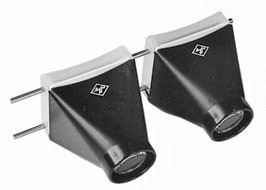


A 3D Camera for 35 mm film
I made this camera back in 1987. Two Konica FS 1 bodies were merged to a 3D-camera. The shutters are synchronized to allow flash photography. It also works with automatic flash exposure when using dedicated Konica flashguns (e.g. X-24). The right exposure meter controls the automatic exposure of both lenses.
The two cameras are separated by one frame. Each frame is 36 mm plus a margin of 2 mm. So the center frame distance is 76 mm. The lenses are separated by 74 mm.
The two cameras are separated by one frame. Each frame is 36 mm plus a margin of 2 mm. So the center frame distance is 76 mm. The lenses are separated by 74 mm.

This is how stereoscopic cameras are made to make the images converge at a certain shooting distance. The stereo window is about 2 meters in front of the camera when using 40 mm lenses.
The film transport scheme is 1-3-1-3... and is handled automatically through a redesign of the frame counter. The knob between the two finder prisms is a double exposure control. This is a modification as the FS-1 does not allow double exposures. A simple switch is all that is necessary to add this functionality. It is surprising that Konica didn't make it as a standard feature.
The film transport scheme is 1-3-1-3... and is handled automatically through a redesign of the frame counter. The knob between the two finder prisms is a double exposure control. This is a modification as the FS-1 does not allow double exposures. A simple switch is all that is necessary to add this functionality. It is surprising that Konica didn't make it as a standard feature.
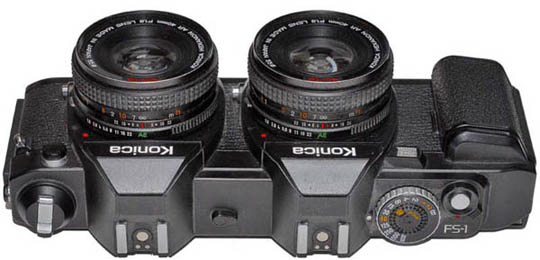
Looking back at camera evolution a few decades is interesting. The Konica FS 1 camera was really ground breaking. Not only was it the first SLR with an automatic film winder, the basic body contours with a battery compartment handgrip was a departure from the looks of SLR cameras until then. This kind of handgrip is mandatory for today's digital SLR cameras. But Konica was a little to eager to launch the camera. The first batches had some teething troubles and Konica got a bad reputation in a short time.
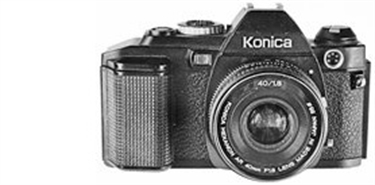
1 + 1 = 3D
Konica FS-1 was introduced in 1979. This was the world's first SLR camera with a built-in electric winder. The modular design of the camera makes it quite easy to hack.
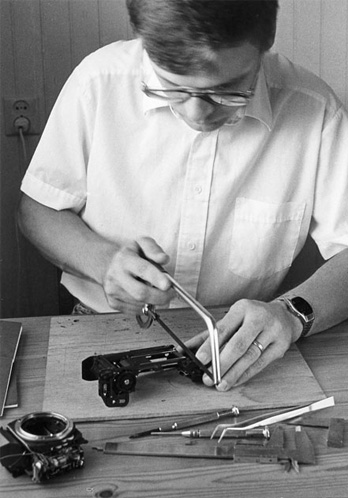

The body is made of aluminium alloy which is easier to customize than plastic. The two cameras were cut and then screwed together. Plastic Padding was used to fill some gaps and holes.


The shutters, automatic exposure and film advance are electronically controlled. Basically there is just one set of FS-1 electronics (with some modifications) controlling both cameras.

Cover parts were screwed and glued with epoxy. Plastic Padding was used to make up the finish and several layers of black paint restored the look of the surfaces. The back cover (film door) is originally made of sheet steel so it was easy to silver solder. I'm glad it wasn’t aluminium - that would have been hard to splice together.
I would really like to make a digital 3D camera. But it is really hard (I hate to use the word "impossible") to merge two digital cameras. I can imagine putting together two cameras and have them act like two separate but fairly well synchronized units. They would have two memory cards etc because it is hard to hack the firmware. It would be nice to have a 3D LCD as well. Such displays exist, but again, the challenge is to hack the firmware. The best approach would probably be to build a camera almost from scratch.
I would really like to make a digital 3D camera. But it is really hard (I hate to use the word "impossible") to merge two digital cameras. I can imagine putting together two cameras and have them act like two separate but fairly well synchronized units. They would have two memory cards etc because it is hard to hack the firmware. It would be nice to have a 3D LCD as well. Such displays exist, but again, the challenge is to hack the firmware. The best approach would probably be to build a camera almost from scratch.
And yes, there were some pieces left over...
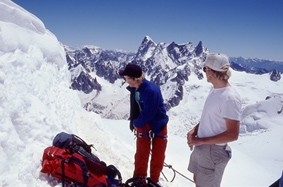
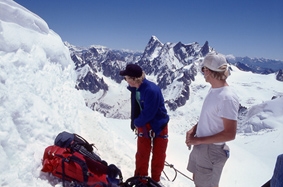
Here’s couple of images for those who master the art of stereoscopic free-viewing.



Photographic 3D slides can be shown with two slide projectors, polarizing filters, polarizing glasses and an aluminium screen (or back projection screen).
This is how things were made in the ancient times when people used the thing called film. In the digital world we have of course been used to 3D-viewing on TV and computers.
Two cheap slide viewers merged with a couple of rods makes a simple 3D viewer.
This is how things were made in the ancient times when people used the thing called film. In the digital world we have of course been used to 3D-viewing on TV and computers.
Two cheap slide viewers merged with a couple of rods makes a simple 3D viewer.
